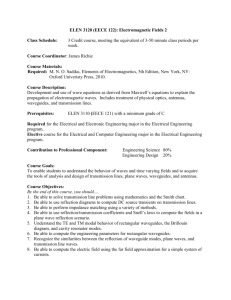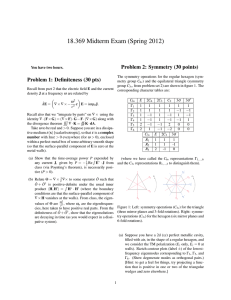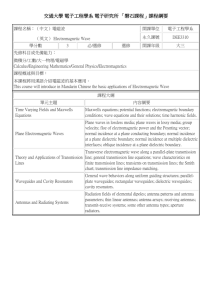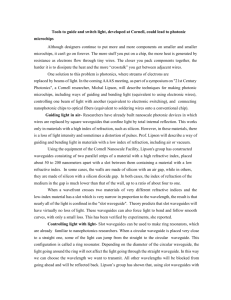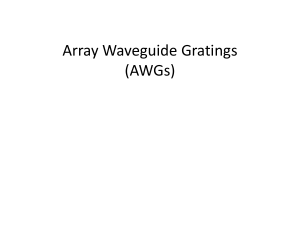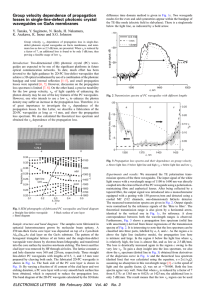Lab 7
advertisement
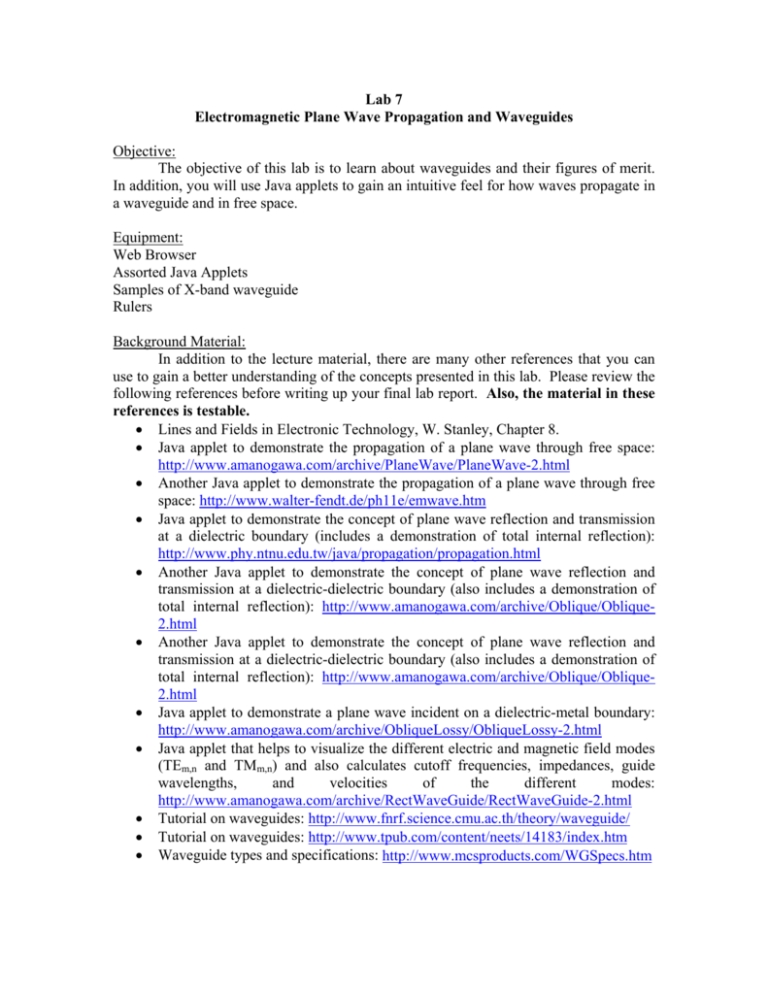
Lab 7 Electromagnetic Plane Wave Propagation and Waveguides Objective: The objective of this lab is to learn about waveguides and their figures of merit. In addition, you will use Java applets to gain an intuitive feel for how waves propagate in a waveguide and in free space. Equipment: Web Browser Assorted Java Applets Samples of X-band waveguide Rulers Background Material: In addition to the lecture material, there are many other references that you can use to gain a better understanding of the concepts presented in this lab. Please review the following references before writing up your final lab report. Also, the material in these references is testable. • Lines and Fields in Electronic Technology, W. Stanley, Chapter 8. • Java applet to demonstrate the propagation of a plane wave through free space: http://www.amanogawa.com/archive/PlaneWave/PlaneWave-2.html • Another Java applet to demonstrate the propagation of a plane wave through free space: http://www.walter-fendt.de/ph11e/emwave.htm • Java applet to demonstrate the concept of plane wave reflection and transmission at a dielectric boundary (includes a demonstration of total internal reflection): http://www.phy.ntnu.edu.tw/java/propagation/propagation.html • Another Java applet to demonstrate the concept of plane wave reflection and transmission at a dielectric-dielectric boundary (also includes a demonstration of total internal reflection): http://www.amanogawa.com/archive/Oblique/Oblique2.html • Another Java applet to demonstrate the concept of plane wave reflection and transmission at a dielectric-dielectric boundary (also includes a demonstration of total internal reflection): http://www.amanogawa.com/archive/Oblique/Oblique2.html • Java applet to demonstrate a plane wave incident on a dielectric-metal boundary: http://www.amanogawa.com/archive/ObliqueLossy/ObliqueLossy-2.html • Java applet that helps to visualize the different electric and magnetic field modes (TEm,n and TMm,n) and also calculates cutoff frequencies, impedances, guide wavelengths, and velocities of the different modes: http://www.amanogawa.com/archive/RectWaveGuide/RectWaveGuide-2.html • Tutorial on waveguides: http://www.fnrf.science.cmu.ac.th/theory/waveguide/ • Tutorial on waveguides: http://www.tpub.com/content/neets/14183/index.htm • Waveguide types and specifications: http://www.mcsproducts.com/WGSpecs.htm Pre-Laboratory Exercise (due at the beginning of class): Read chapter 8-1 to 8-4 in the Stanley textbook and solve the following problems: 1. Determine the cutoff frequencies for (a) the dominant mode (b) the TE20 and (c) the TM11 modes in a WR-28 rectangular waveguide with air dielectric. The inner dimensions are a = 7.112 mm and b=3.556 mm. Procedure: This lab involves an interactive lecture with the course instructor and culminates with a paper assignment due the following week. The lecture is includes the following topics: • Plane wave propagation. Java applets are used to help the students visualize how a plane wave propagates in free space. • Reflection and transmission of wave at material interfaces (including a discussion and demonstration of total internal reflection). • How information (signals) are sent electromagnetically between two points in space: transmission lines, free space (antennas), waveguides. The discussion centers on why we would use one modality over another and specifically when we would use waveguides. • Types of waveguides. Specifically dielectric-dielectric interface waveguides (fiber optics) and dielectric-conductor waveguides (microwave frequencies). • Detailed discussion of rectangular waveguides including discussion and demonstration of: o TE and TM modes o Problems associated with the coexistence of multiple modes o Calculation of mode cutoff frequencies o Concept of a fundamental or dominant mode o Calculation of guide wavelength o Calculation of waveguide impedance o Calculation of group velocity • Example problem using X band (WR-90) waveguide where the guide dimensions are measured, the cutoff frequencies are calculated, the band of suitable frequencies is estimated. Post-Lab Write-up: For the lab write-up, each lab group (team of two) will be responsible for turning in report on waveguides with the following sections: 1. Theory of Waveguides: Discussion of the types of waveguides (dielectric vs metal), why we use waveguides, how waveguides work, detailed discussion of the rectangular waveguide, etc… 2. Summary of Rectangular Waveguide Calculations: Discussion of how we calculate waveguide parameters such as cutoff frequencies, operating range, guide wavelengths, guide impedances, guide velocities, etc…. 3. Waveguide Application: Discussion of a real-world example of the use of waveguides. This section should discuss the application, the reasons why waveguides are used (in lieu of other transmission modalities), and the specifications of the waveguide being used (dimensions, operating frequencies, conductivity, …) 4. Example Calculations: For the waveguide discussed in the application section (You may use the Java applet as discussed in lab to do you calculations, but you must show screen captures of your results. Alternatively, you can do your calculations by hand): a. Calculate the cutoff frequencies for the five lowest order modes and identify the dominant mode. b. Prove that the specified operating frequencies coincide with the dominant mode. c. Calculate the guide wavelength, guide impedance, and group velocity over the operating frequency band of the guide.
